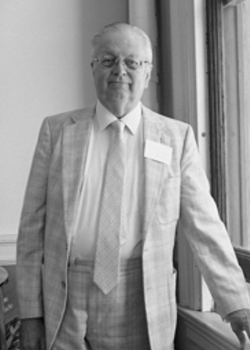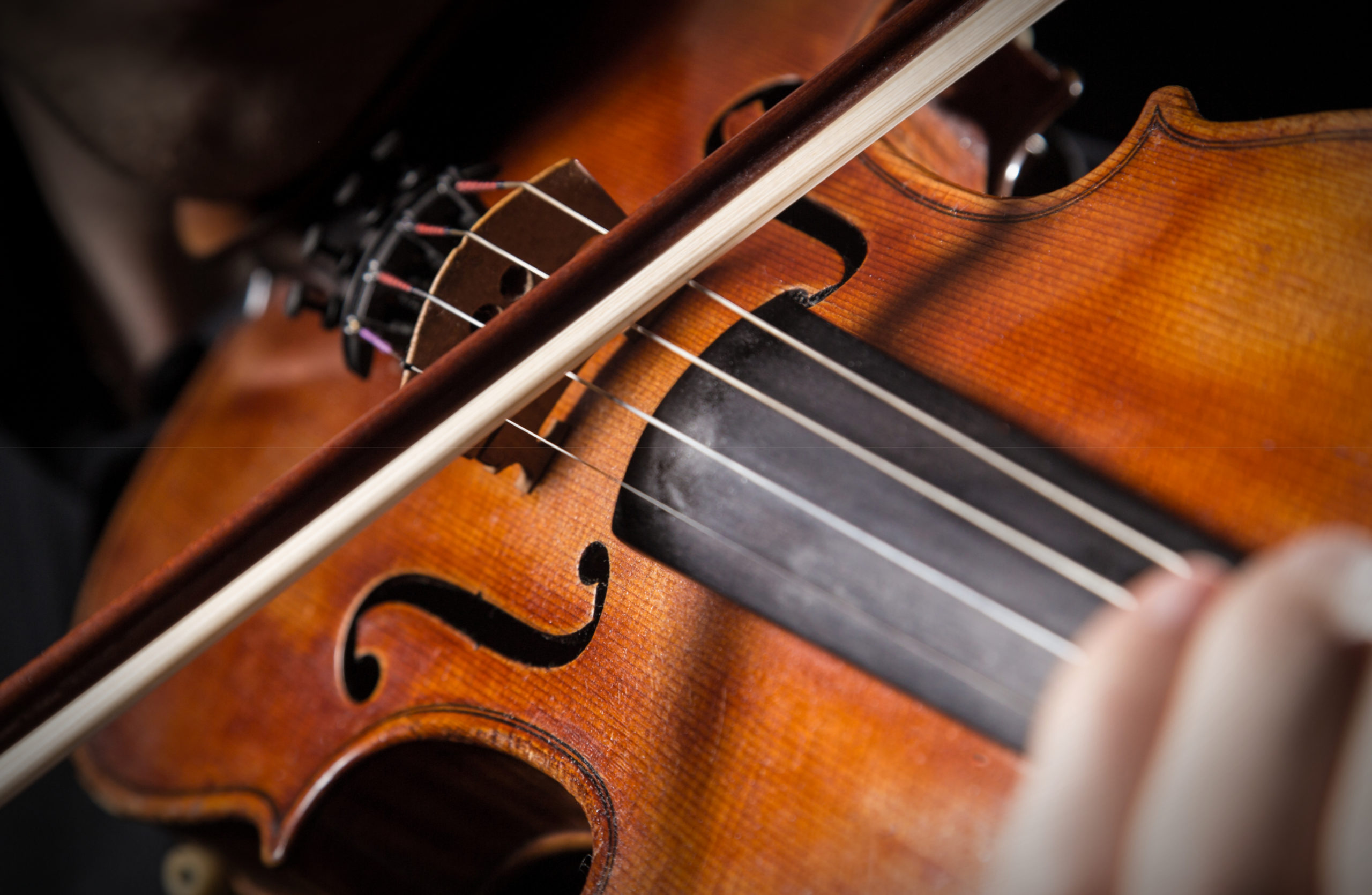
Maurice Riley
(1981-1986)
by Dwight Pounds
There is a folder upstairs in my filing cabinet that I highly treasure. It is labeled “Correspondence with Maurice Riley” and is about three-quarters of an inch thick. The first entry was in 1981, the last in 1997. It consists primarily of one-page letters between Dr. Riley and myself. There was good reason for this active correspondence–during the years he was the AVS President (1981-1986), it was my honor to serve him and the Society as Vice President. The unlikely fact that I was vice president in only my sixth year of membership was his doing entirely. Well, perhaps not entirely . . . I volunteered for something, breaking a rule learned years earlier in the Air Force.
Following Congress VII in 1979, many congress participants were riding a bus from Provo to Salt Lake City to make airline connections. Myron Rosenblum and Maurice Riley shared a seat and were discussing both the congress and the future of the Society. During a lull in their conversation I turned to them and said, “Although by no means an artist violist, I have some organizational skills that might be of use to the Society,” expecting perhaps a committee assignment or suggestion for an article. Dr. Riley looked at me with a face any poker player would have coveted and said, “Good. You can be vice president!”
There were several facts to which I was not privy at that point: (1) The American Viola Society and its Newsletter were run from the living room of Myron Rosenblum’s home. An Executive Board did exist, but it was more honorary than functional. (2) A new slate of officers would assume duties in 1981. Dr. Rosenblum, the Society’s founder, had decided not to run for another term as president, and Maurice Riley was the most likely candidate to succeed him. (3) A deadpan wit, without equal in my experience, was part of his persona and would lead me down the Primrose path more than once. Despite what initially appeared to be a preposterous response (“. . . be vice president!”) to my offer, Dr. Riley was serious. Two years later Maurice Riley and Dwight Pounds were elected, respectively, President and Vice President of the American Viola Society. Although somewhat baffled at my new position, there was no doubt in my mind that the gentleman who hosted the very first North American Viola Congress at Ypsilanti in 1975 was exactly the man to succeed Myron Rosenblum as AVS President.
Maurice Riley in some respects stumbled upon international viola organization. He traveled extensively, visiting libraries and archives as he assembled and organized bits of data pertinent to the viola’s history. When one of Rosenblum’s early articles on the Viola Research Society (VRS) (which later became the International Viola Society) and the Kassel Viola Archive came into his possession, he determined to inquire further about the organization. He began corresponding with Dietrich Bauer, VRS Secretary and Viola Archive custodian, and traveled to Kassel, Germany, in 1971 to meet with Bauer and examine the archive. It is important to remember that at that time there were (1) no independent American or other international sections of the VRS and (2) no viola congresses had ever been held. During a discussion of the concept of “viola congresses,” Riley asked his host why such a meeting could not be held in the United States. Bauer answered, “Because we have never been invited.” Riley replied, “Well, in that case I am inviting you to have a viola congress in the United States.” He told me years later that this invitation was entirely spontaneous, but that he saw enormous potential in an international viola congress. Bauer was obviously impressed and took the proposal to the VRSPresidium. The minutes of the next meeting read: “Prof. Riley from the USA was in the archive and extended an invitation for an international viola congress to be held in the United States.” Four years later Dr. Maurice Riley hosted International Viola Congress III at Eastern Michigan University, Ypsilanti, Michigan, and established many of the precedents, formats, and traditions that are still followed both in Europe and North America twenty-two congresses later.
Somewhat intimidated to be working in close association with such a renowned scholar, I was ever reluctant to address him as “Maurice.” Using “Dr. Riley” seemed stiff and formal for a man of obvious congeniality, therefore I opted for “Professor.” After several letters from me that began, “Dear Professor,” the following rejoinder arrived from Ypsilanti:
“You always address me in your letters as ‘Professor.’ I can assure you that I am unworthy of this title by either chosen instrument or locale of performance. I am sure that you know that the term ‘Professor’ applies only to fellows who play the piano in brothels.”
Intent on continuing my education, official correspondence was accompanied by such masterpieces as: A Dog Named “Sex;” English Schoolteacher Rents Room for Summer Vacation; Petey the Snake (tongue twister); and the Nathan Hale Aptitude Test, as well as countless cartoons, jokes, and one-liners. Still, Maurice and I formed a close professional and personal relationship that lasted far beyond our terms in office. Dinner with the Riley family at congresses was always a wonderful experience. Since Maurice Riley spoke very little German and IVS President Franz Zeyringer was not conversant in English, I functioned as their translator. These six years of sometimes-weekly contact with Riley and Zeyringer changed the course of my professional life. At the behest of each, I began gathering and organizing data and materials for a history of the American Viola Society. This work was dedicated to Maurice Riley, Myron Rosenblum, David Dalton, and Franz Zeyringer.
During President Riley’s term of office, several noteworthy developments took place. The AVS By-Laws, written by Maurice, Bob Oppelt, and myself in 1980, were expanded. AVS Executive Board membership moved from being an honorary position to one of hands-on activity and involvement. William Primrose died. International Viola Congresses were held in Toronto, Stuttgart, Houston, Isle of Man, and Boston; Dr. Riley attended each. AVS membership increased. The History of the Viola was translated into Italian. He was recipient of the International Viola Society Silver Key in 1985, the International Viola Society Honorary Membership in 1986, and American Viola Society Honorary Membership in 1991. Following his presidency, Congress XXI in Evanston, Illinois, 1993, was dedicated to the collective members of the Riley family. The MAURICE W. RILEY VIOLA AWARD, inaugurated by Rosemary Glyde, became the highest AVS award for scholarship, teaching, and service to the Society. Inconsistent health did not preclude his participation in viola congresses. During Congress XIX at Ithaca, New York (1991), he presented a lecture, sat on a panel, and received honors. At great personal effort he attended AVS Board meetings as an interested observer, advisor and mentor. While planning the latest congress, Roger Myers, host of Congress XXV at the University of Texas, sought Dr. Riley’s advice only weeks before his passing.
Just as we pay him homage today, he did the same to those who had labored in behalf of the viola before him. Concluding his chapter on “The Future of the Viola” in History of the Viola, Volume I, Maurice Riley wrote:
“Tertis and Primrose succeeded as concert artists because of their dedication to the instrument, their love of it, their ability to convince others of the viola’s potential, and above all, their great artistry. Others, lacking their artistry and charisma, can do, and are doing, much for the instrument and for themselves by developing and spreading a faith in its unique qualities, and by constantly promoting, publicizing, and propagandizing the salient virtues of this magnificent voice.”
At no point would it have occurred to this tireless scholar that, more than any other person, he was describing himself.
There is a folder upstairs in my filing cabinet that I highly treasure. It is labeled “Correspondence with Maurice Riley” and is about three-quarters of an inch thick. It is quite small compared to what is stored in the hearts and minds of violists and scholars who ever knew Maurice Winton Riley.

